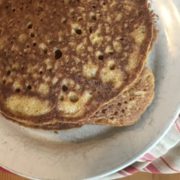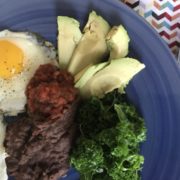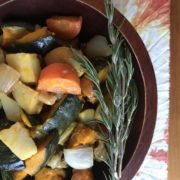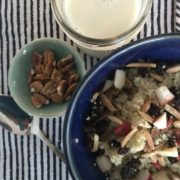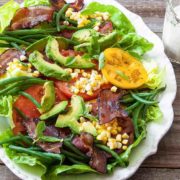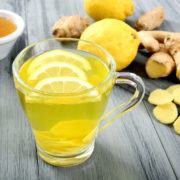Best Sprouted Buckwheat Pancakes
We make these pancakes about once a week in our house. They’re easy to make, nutritious, and really hard to mess up! We usually make some kind of a fruit topping for these so we don’t use as much maple syrup (see Blueberry topping in the Sauces/Dressings section), but you could also eliminate the maple syrup and use this as a savory pancake to go with a curry, stir fry, or other inspired topping.
Soaking grains helps to degrade their naturally occurring phytates. Phytates keep grains from growing into a plant when they’re not in the proper environment, but once they’re exposed to water, phytate decreases and the seed starts to sprout.
**You need to soak the buckwheat groats for at least 10-12 hours, so be prepared for that**
Makes 9 large pancakes
Ingredients
2 cups buckwheat groats (do not confuse with kashi, which are toasted buckwheat groats)
3 -4 cups water
3 tbsps apple cider vinegar or lemon juice
3/4 cup milk
3 tbsp maple syrup *optional
3 eggs separated
1 tbsp vanilla
1 tsp baking soda
3/4 tsp salt
Coconut oil for cooking
Instructions
Put buckwheat groats in a bowl with the water and apple cider vinegar. Soak for at least 10-12 hours, or you can change the water and keep soaking for another day/night. The water will be a slimy consistency which is how it’s supposed to be.
Put all ingredients except egg whites into your blender or food processor and blend until smooth. In a separate bowl, whip egg whites until soft peaks form. Add the batter to the egg whites and fold together gently.
In a stainless steel or cast iron frying pan melt coconut oil over medium heat. Test heat by flicking a tiny bit of water onto the pan – the water should bubble slightly when it’s hot enough. Pour in desired amount of pancake batter and flip once bubbles have formed over the entire pancake.
Add your favorite toppings and enjoy!
These are hearty pancakes, so if you can’t eat all the batter, store it in the fridge for 2-3 days for fresh pancakes on demand!! YUM!!

